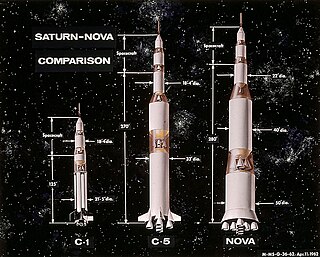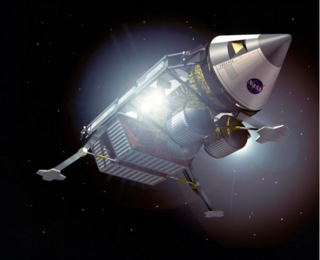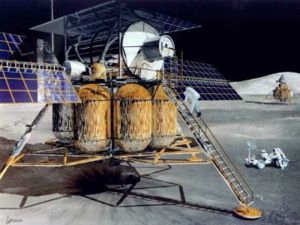
The S-IVB was the third stage on the Saturn V and second stage on the Saturn IB launch vehicles. Built by the Douglas Aircraft Company, it had one J-2 rocket engine. For lunar missions it was fired twice: first for Earth orbit insertion after second stage cutoff, and then for translunar injection (TLI).

The Saturn family of American rockets was developed by a team of mostly German rocket engineers and scientists led by Wernher von Braun to launch heavy payloads to Earth orbit and beyond. The Saturn family used liquid hydrogen as fuel in the upper stages. Originally proposed as a military satellite launcher, they were adopted as the launch vehicles for the Apollo Moon program. Three versions were built and flown: the medium-lift Saturn I, the heavy-lift Saturn IB, and the super heavy-lift Saturn V.

The Constellation program was a crewed spaceflight program developed by NASA, the space agency of the United States, from 2005 to 2009. The major goals of the program were "completion of the International Space Station" and a "return to the Moon no later than 2020" with a crewed flight to the planet Mars as the ultimate goal. The program's logo reflected the three stages of the program: the Earth (ISS), the Moon, and finally Mars—while the Mars goal also found expression in the name given to the program's booster rockets: Ares. The technological aims of the program included the regaining of significant astronaut experience beyond low Earth orbit and the development of technologies necessary to enable sustained human presence on other planetary bodies.
The Saturn I was a rocket designed as the United States' first medium lift launch vehicle for up to 20,000-pound (9,100 kg) low Earth orbit payloads. The rocket's first stage was built as a cluster of propellant tanks engineered from older rocket tank designs, leading critics to jokingly refer to it as "Cluster's Last Stand". Its development was taken over from the Advanced Research Projects Agency in 1958 by the newly formed civilian NASA. Its design proved sound and flexible. It was successful in initiating the development of liquid hydrogen-fueled rocket propulsion, launching the Pegasus satellites, and flight verification of the Apollo command and service module launch phase aerodynamics. Ten Saturn I rockets were flown before it was replaced by the heavy lift derivative Saturn IB, which used a larger, higher total impulse second stage and an improved guidance and control system. It also led the way to development of the super-heavy lift Saturn V which carried the first men to landings on the Moon in the Apollo program.

Nova was a series of NASA rocket designs that were proposed both before and after the Saturn V rocket used in the Apollo program. Nova was NASA's first large launcher proposed in 1958, for missions similar to what Saturn V was subsequently used for. The Nova and Saturn V designs closely mirrored each other in basic concept, power, size, and function. Differences were minor but practical, and the Saturn was ultimately selected for the Apollo program, largely because it would reuse existing facilities to a greater extent and could make it to the pad somewhat earlier.

The F-1, commonly known as Rocketdyne F1, was a rocket engine developed by Rocketdyne. This engine uses a gas-generator cycle developed in the United States in the late 1950s and was used in the Saturn V rocket in the 1960s and early 1970s. Five F-1 engines were used in the S-IC first stage of each Saturn V, which served as the main launch vehicle of the Apollo program. The F-1 remains the most powerful single combustion chamber liquid-propellant rocket engine ever developed.
The Apollo Applications Program (AAP) was created as early as 1966 by NASA headquarters to develop science-based human spaceflight missions using hardware developed for the Apollo program. AAP was the ultimate development of a number of official and unofficial Apollo follow-on projects studied at various NASA labs. However, the AAP's ambitious initial plans became an early casualty when the Johnson Administration declined to support it adequately, partly in order to implement its Great Society set of domestic programs while remaining within a $100 billion budget. Thus, Fiscal Year 1967 ultimately allocated $80 million to the AAP, compared to NASA's preliminary estimates of $450 million necessary to fund a full-scale AAP program for that year, with over $1 billion being required for FY 1968. The AAP eventually led to Skylab, which absorbed much of what had been developed under Apollo Applications.

The Space Transportation System (STS), also known internally to NASA as the Integrated Program Plan (IPP), was a proposed system of reusable crewed space vehicles envisioned in 1969 to support extended operations beyond the Apollo program.. The purpose of the system was two-fold: to reduce the cost of spaceflight by replacing the current method of launching capsules on expendable rockets with reusable spacecraft; and to support ambitious follow-on programs including permanent orbiting space stations around Earth and the Moon, and a human landing mission to Mars.

The Exploration Systems Architecture Study (ESAS) is the official title of a large-scale, system level study released by the National Aeronautics and Space Administration (NASA) in November 2005 of his goal of returning astronauts to the Moon and eventually Mars—known as the Vision for Space Exploration. The Constellation Program was cancelled in 2010 by the Obama Administration and replaced with the Space Launch System, later renamed as the Artemis Program in 2017 under the Trump Administration.

The Altair spacecraft, previously known as the Lunar Surface Access Module or LSAM, was the planned lander spacecraft component of NASA's cancelled Constellation program. Astronauts would have used the spacecraft for landings on the Moon, which was intended to begin around 2019. The Altair spacecraft was planned to be used both for lunar sortie and lunar outpost missions. On February 1, 2010, U.S. President Barack Obama announced a proposal to cancel the Constellation program, to be replaced with a re-scoped program, effective with the U.S. 2011 fiscal year budget.

The Aerojet M-1 was the largest and most powerful liquid-hydrogen-fueled liquid-fuel rocket engine to be designed and component-tested. It was originally developed during the 1950s by the US Air Force. The M-1 offered a baseline thrust of 6.67 MN and an immediate growth target of 8 MN. If built, the M-1 would have been larger and more efficient than the famed F-1 that powered the first stage of the Saturn V rocket to the Moon.

The Ares V was the planned cargo launch component of the cancelled NASA Constellation program, which was to have replaced the Space Shuttle after its retirement in 2011. Ares V was also planned to carry supplies for a human presence on Mars. Ares V and the smaller Ares I were named after Ares, the Greek god of war.

Ares I was the crew launch vehicle that was being developed by NASA as part of the Constellation program. The name "Ares" refers to the Greek deity Ares, who is identified with the Roman god Mars. Ares I was originally known as the "Crew Launch Vehicle" (CLV).
The Saturn C-2 was the second rocket in the Saturn C series studied from 1959 to 1962. The design was for a four-stage launch vehicle that could launch 21,500 kg (47,300 lb) to low Earth orbit and send 6,800 kg (14,900 lb) to the Moon via Trans-Lunar Injection.
The C-2 design concept was for a proposed crewed circumlunar flight and the Earth orbit rendezvous (EOR) missions. It was initially considered for the Apollo lunar landing at the earliest possible date (1967).

The Saturn C-3 was the third rocket in the Saturn C series studied from 1959 to 1962. The design was for a three-stage launch vehicle that could launch 45,000 kilograms (99,000 lb) to low Earth orbit and send 18,000 kilograms (40,000 lb) to the Moon via trans-lunar injection.

Saturn V is a retired American super heavy-lift launch vehicle developed by NASA under the Apollo program for human exploration of the Moon. The rocket was human-rated, had three stages, and was powered with liquid fuel. It was flown from 1967 to 1973. It was used for nine crewed flights to the Moon, and to launch Skylab, the first American space station.

A super heavy-lift launch vehicle is a rocket that can lift to low Earth orbit a "super heavy payload", which is defined as more than 50 metric tons (110,000 lb) by the United States and as more than 100 metric tons (220,000 lb) by Russia. It is the most capable launch vehicle classification by mass to orbit, exceeding that of the heavy-lift launch vehicle classification.

During the lifetime of the Space Shuttle, Rockwell International and many other organizations studied various Space Shuttle designs. These involved different ways of increasing cargo and crew capacity, as well as investigating further reusability. A large focus of these designs were related to developing new shuttle boosters and improvements to the central tank, but also looked to expand NASA's ability to launch deep space missions and build modular space stations. Many of these concepts and studies would shape the concepts and programs of the 2000s such as the Constellation, Orbital Space Plane Program, and Artemis program.

The International Lunar Resources Exploration Concept (ILREC) was a proposed mission architecture under President George H. W. Bush's Space Exploration Initiative (SEI) by Kent Joosten, an engineer at Johnson Space Center. The plan would have used the help of international partners, mainly the Soviet Union, to assemble a lunar base and sustainable lunar transportation service.

First Lunar Outpost was a proposal for a crewed lunar mission that would have launched sometime in the 2010s. It was part of George H. W. Bush's Space Exploration Initiative. The main purpose of the proposal was to offer a much cheaper alternative to NASA's 90-day study from 1989 by a factor of US$30 billion. Although it did not gather much mainstream attention, NASA dedicated much time to assembling a very detailed and thorough proposal. However, the entire Space Exploration Initiative was cancelled soon after the proposal's completion, and NASA had to close the Office of Space Exploration in March 1993.

















